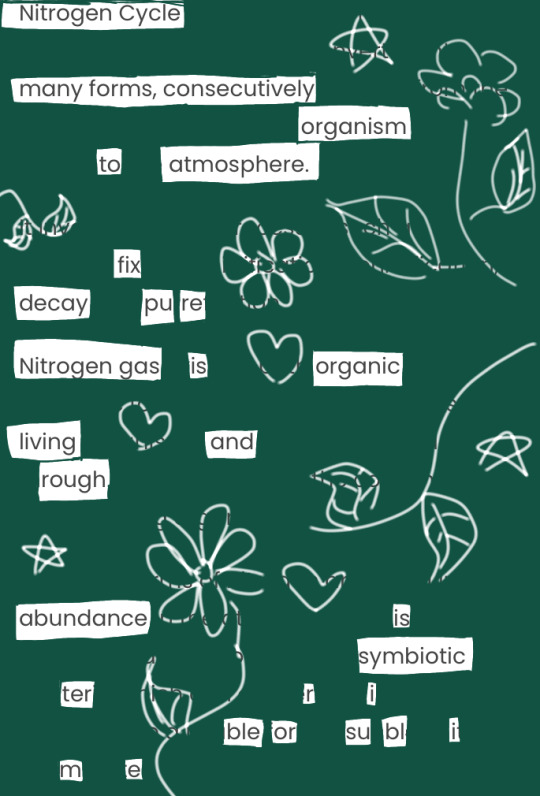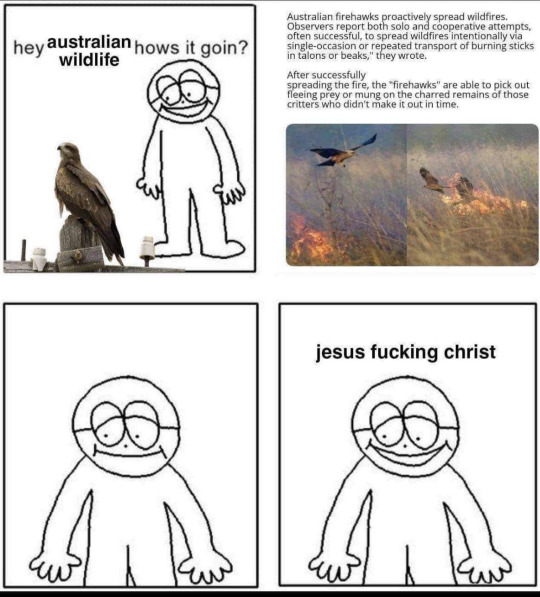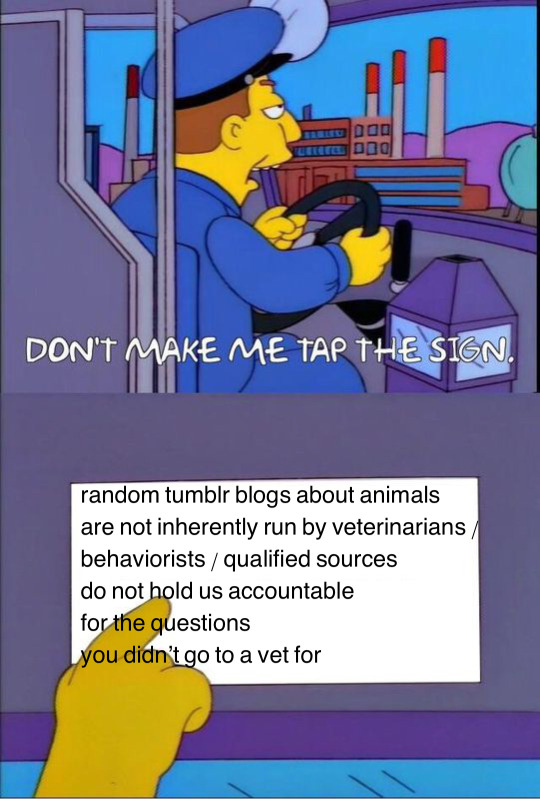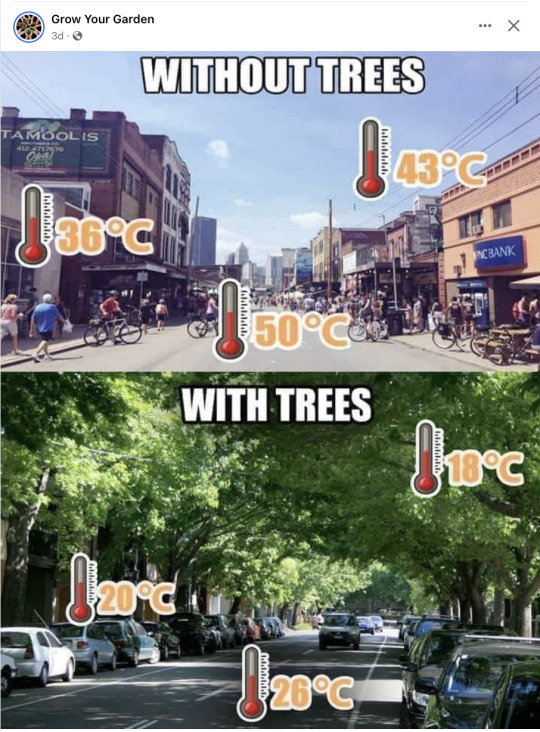#Environmental Sciences
Text
PFAS have earned the name "forever chemicals" with good reason—the man-made compounds, which can take thousands of years to degrade and are found in everything from grease-resistant food packaging to water-repellent clothing, have made their way into nearly half the U.S. tap water supply.
Now, in a study featured in the Journal of Hazardous Materials, New Jersey Institute of Technology chemists have demonstrated a new lab-based method to detect traces of PFAS from food packaging material, water and soil samples in just three minutes or less.
Continue Reading.
#Science#Chemistry#Environmental Sciences#Water#Plastic#Forever Chemicals#PFAS#Per- and Polyfluoroalkyl Substances
110 notes
·
View notes
Text

studying for environmental sciences is going well :3
[id: a blackout poem made from an article on the nitrogen cycle. it reads “Nitrogen Cycle. many forms, consecutively, organism to atmosphere. fix, decay, pure. Nitrogen gas is organic, living, and rough. abundance is symbiotic. terrible or sublime.” the rest of the article is covered up with dark green and doodles of flowers, hearts, and stars. end id]
51 notes
·
View notes
Note
Hey I just saw you're most recent post and if you don't mind explaining a little more, could you explain? I know Grace was a scientist. I just don't know a lot about environment science stuff. Like what do you do? I am so interested to know. Is it similar to Grace?
HEY oh my gosh I’m excited to explain! So Grace was a botanist. Specialising in plants or “flora”. The environmental sciences sector covers a large range of subjects. Ranging from microbiology (can also be a biomedical topic) to ecology. Honestly the subject is so vast I couldn’t possibly explain everything I will definitely encourage you to look into it more if the urge strikes you!
So Grace was a research scientist, these people work in the filed and often are the frontline of new discoveries. For a scientist of any kind to be able to go to a new planet and discover new flora and fauna (plants and animals) is a dream come true. Grace probably had very little interaction with earths wildlife if it even existed when she was there.
Now for me? I am currently studying a Zoology degree. My subjects are vast and my knowledge won’t become more narrow for a few years. You don’t get to really specialise until masters or even PHD. I am studying with the goal of working to push the reintroduction of predatory keystone species into their native environments in hopes this can kickstart a recovery in the surrounding ecosystem and biome. At least that’s how I explain my job aspirations to my lectures, if anyone has heard of the wolves being put back in Yellowstone? Yeah I want to recreate that all over the world. Grace was on some level a conservationist. At least from my interpretation of her character.
She pushes to protect life she wants to understand it to its fullest and this is something I relate to.
#avatar way of water#avatar the movie#avatar#grace augustine#scientist#conservation#environement#environmental sciences#a little about me
8 notes
·
View notes
Text
Call for Research Article | INNSPUB Journals
The International Network for Natural Sciences (INNSPUB) invites all prospective research scholars to read and welcome to submit their original quality manuscript for quick publish of a research paper, review paper, short communications, research reports, technical reports, intellectual articles, conceptual papers, and latest research & findings on Life sciences, Environmental Sciences, Agricultural Sciences, Health Sciences, and Bio-medicinal science which are not under review or under consideration for publish in any other international academic journal.
2 notes
·
View notes
Text
Vegetative propagation technologies using stem and root cuttings of Paulownia tree species for mass production | JBES 2021
Vegetative propagation technologies using stem and root cuttings of Paulownia tree species for mass production | JBES 2021
Mr. Anthony Antwi-Wiredu, Patience Mansa Gakpetor, Reginald Tang Guuroh, Ebenezer Ofori, and Mr. Daniel Aninagyei Ofori, from the Institute of the CSIR-Forestry Research Institute of Ghana, KNUST, Kumasi, Ghana, wrote a research paper about Root cuttings technologies of Paulownia tree species for mass production. Let’s get some knowledge about the rooted cutting of the Paulownia…

View On WordPress
#diversity#Environmental Sciences#Indole-3-butyric acid#Paulownia#Root and stem cuttings#Sprouting and rooting potentials#Vegetative propagation
3 notes
·
View notes
Text
"In one of Africa’s last great wildernesses, a remarkable thing has happened—the scimitar-horned oryx, once declared extinct in the wild, is now classified only as endangered.
It’s the first time the International Union for the Conservation of Nature (IUCN), the world’s largest conservation organization, has ever moved a species on its Red List from ‘Extinct in the Wild’ to ‘Endangered.’
The recovery was down to the conservation work of zoos around the world, but also from game breeders in the Texas hill country, who kept the oryx alive while the governments of Abu Dhabi and Chad worked together on a reintroduction program.
Chad... ranks second-lowest on the UN Development Index. Nevertheless, it is within this North African country that can be found the Ouadi Rimé-Ouadi Achim Faunal Reserve, a piece of protected desert and savannah the size of Scotland—around 30,000 square miles, or 10 times the size of Yellowstone.
At a workshop in Chad’s capital of N’Djamena, in 2012, Environment Abu Dhabi, the government of Chad, the Sahara Conservation Fund, and the Zoological Society of London, all secured the support of local landowners and nomadic herders for the reintroduction of the scimitar-horned oryx to the reserve.
Environment Abu Dhabi started the project, assembling captive animals from zoos and private collections the world over to ensure genetic diversity. In March 2016, the first 21 animals from this “world herd” were released over time into a fenced-off part of the reserve where they could acclimatize. Ranging over 30 miles, one female gave birth—the first oryx born into its once-native habitat in over three decades.
In late January 2017, 14 more animals were flown to the reserve in Chad from Abu Dhabi.
In 2022, the rewilded species was officially assessed by the IUCN’s Red List, and determined them to be just ‘Endangered,’ and not ‘Critically Endangered,’ with a population of between 140 and 160 individuals that was increasing, not decreasing.
It’s a tremendous achievement of international scientific and governmental collaboration and a sign that zoological efforts to breed endangered and even extinct animals in captivity can truly work if suitable habitat remains for them to return to."
-via Good News Network, December 13, 2023
#chad#abu dhabi#north africa#rewilding#endangered species#conservation#zoology#conservation biology#oryx#good news#hope#texas#big game#animals#endangered#environmentalism#environmental science#zoo#zoos#zoo animals
24K notes
·
View notes
Text
Pair of Endangered Corpse Flowers Defy Odds to Bloom at Same Time–Now Bearing 700 Seeds https://www.goodnewsnetwork.org/pair-of-endangered-corpse-flowers-defy-odds-to-bloom-at-same-time-now-bearing-700-seeds/
34K notes
·
View notes
Text

Source
More of this
#government#environment#environmentalism#environmetalists#climate science#climate activism#news#current events#Europe#the left#progressive
19K notes
·
View notes
Text
Blue Meanies Mushroom
Blue Meanies: Exploring the Enigmatic World of Psychedelic Fungi
the Blue Meanies mushroom stands out as an intriguing member of the psychedelic fungi family. Let's delve into the origins, effects, and cultural significance of Blue Meanies.
Origins:
Blue Meanies, scientifically known as Panaeolus cyanescens, are a potent species of psychedelic mushrooms. Widely distributed across different regions of the world, these mushrooms are often found in grassy areas, thriving on fertilized soil or manure-rich substrates.
Appearance:
With their distinctive blue coloration, Blue Meanies catch the eye when bruised or damaged, thanks to compounds like psilocin and psilocybin. Adorned with conical caps and dark gills that gradually turn black as spores mature, these mushrooms present an intriguing sight. As the mushroom ages, the stem transforms from white to a darker shade.
Psychoactive Compounds:
Blue Meanies, like many psychedelic mushrooms, contain psychoactive compounds such as psilocybin and psilocin. These compounds interact with serotonin receptors in the brain, provoking altered perceptions, heightened sensory experiences, and shifts in consciousness.
Effects:
Renowned for their potency, Blue Meanies induce profound effects. Users often experience intense visual hallucinations, altered perception of time and space, and an increased sense of interconnectedness with their surroundings. The trip typically lasts between 4 to 6 hours, though the intensity may vary from person to person.
Cautionary Note:
It's crucial to approach the use of psychedelic substances, including Blue Meanies, with caution. Potential risks exist, and factors like set and setting, as well as the user's mental state, significantly influence the overall experience.
Cultural Significance:
Psychedelic mushrooms, including Blue Meanies, hold a rich cultural history. Indigenous cultures have long utilized these fungi in religious and shamanic rituals. In contemporary society, individuals seek out these mushrooms for spiritual experiences, personal insights, or recreational enjoyment.
Legality:
In terms of legality, it's important to research and understand the regulations surrounding psychedelic substances in your specific location.
#blue meanie#blue meanies#blue meanies for sale#Blue Meanies Mushroom#brain science#buy blue meanies#buy blue meanies online#canadian shroomer#copelandia#Copelandia Cyanescens#environmental sciences#health science#human science#lsd experience#mushroom experience#panaeolus cyanescens#psilocybe cyanescens#Psilocybe semilanceata#psilocybe species#psilocybe tasmaniana#psilocybin experience#psychedelic experience#science insider#shroom live experience#shroom types and names#shrooms experience#spiritual experience#strongest species#terance mckenna#where to buy blue meanies
1 note
·
View note
Text

#green memes for ecological fiends#zoology#ecology#bird#hawks#environmental science#biodiversity#conservation biology#conservation#wildlife
28K notes
·
View notes
Text

#i have a degree in environmental science and im very knowledgeable about birds however this does not mean i have an easy access encyclopedia#Of bird afflictions#In my brain
9K notes
·
View notes
Text

Welcome to my Tuesday morning PSA about plastics!
So--I was walking along the Bolstadt beach approach sidewalk here in Long Beach, WA yesterday afternoon, and I started seeing these little orange pellets on the ground that looked a little bit like salmon roe (but probably weren't). So I picked one up, and it was most definitely rubber. I went around picking up every one I could find, and while I didn't keep exact count I probably amassed 50-60 of them. I took this picture before depositing them in the nearest trash can.
These are airsoft gun pellets, and you can buy them in big jars containing thousands of them. That means that someone who decided that the beach was a great place to shoot their airsoft guns could easily litter the place with countless little bits of plastic rubber in less than an hour. We already have a huge problem here with people leaving trash, including tiny bits of plastic, all over the beach (you should see the gigantic mess after 4th of July fireworks when thousands of people come in from out of town, blow things up, and then leave again without picking up after themselves.)
But these airsoft pellets have a particularly nasty side effect. You know how my first thought was "wow, those look kind of like salmon roe?" Well, we have a number of opportunistic omnivore birds like crows, ravens, and several species of gull that commonly scavenge on the beach, especially along the approaches because people often feed them there. If I can catch the resemblance of an orange airsoft pellet to a fish egg, then chances are there are wildlife that will assume they're edible.
Since birds don't chew their food, they probably won't notice that the taste or texture is wrong--it'll just go down the hatch. And since they can't digest the pellets, there's a good chance they might just build up in the bird's digestive system, especially if the bird eats a large number of them--say, fifty or sixty of them dropped on the ground along the same fifty foot stretch of sidewalk. The bird might die of starvation if there's not enough capacity for food in their stomach--or they might just die painfully of an impacted gut, and no way to get help for it. If the pellets end up washed into the ocean, you get the same issue with fish and other marine wildlife eating them, and then of course the pellets eventually breaking up into microplastic particles.
You can get biodegradable airsoft pellets; they appear to mainly be gray or white in color rather than bright screaming orange and green. But "biodegradable" doesn't mean "instantly dissolves the next time it rains." An Amazon listing for Aim Green biodegradable airsoft pellets advertise them as "Our biodegradable BBs are engineered to degrade only with long-term exposure to water and sun and will degrade 180 days after being used." That's half a year for them to be eaten by wildlife.
I don't know, y'all. That handful of carelessly dropped rubber pellets just encapsulates how much people don't factor in the rest of nature when making decisions, even on something that is purely for entertainment like an airsoft gun. We could have had a lot of the same technological advances we have today, but with much less environmental impact, if we had considered the long-term effects on both other people and other living beings, as well as our habitats. We could have found ways from the beginning to make these things in ways that benefited us but also mitigated any harm as much as possible. Instead we're now having to reverse-engineer things we've been using for decades, and sometimes--like the "biodegradable" airsoft pellets--they still have a significant negative impact.
But--at least there are people trying to do things better, thinking ahead instead of just on immediate profit. We're stuck in a heck of a mess here, figuratively and literally, and changing an entire system can't be done in a day. Maybe we can at least keep pushing for a cultural shift that emphasizes planning far into the future--if not the often-cited "seven generations ahead", then at least throughout the potential lifespan of a given product.
#plastics#microplastics#environment#environmentalism#conservation#nature#pollution#litter#birds#tw animal death#animal welfare#ecology#science#wildlife#animals#scicomm#pnw#airsoft#biodegradable#solarpunk
4K notes
·
View notes
Text

“It is not so much for its beauty that the forest makes a claim upon men’s hearts, as for that subtle something, that quality of air that emanation from old trees, that so wonderfully changes and renews a weary spirit.”
― Robert Louis Stevenson
Source: Grow Your Garden Instagram page
#katia plant scientist#botany#plant biology#plant science#plants#trees#plants make people happy#sustainability#ecological#solarpunk#intersectional environmentalism#environmentalism
2K notes
·
View notes
Text
What Is JBES Journal?

JBES Journal
JBES is the short name of the Journal of Biodiversity and Environmental Sciences, an open-access scholarly research journal on Environmental Sciences and Biodiversity. Journal of Biodiversity and Environmental Sciences |JBES is a fast and peer-reviewed journal and is scheduled to publish 12 issues in a year. It publishes original research papers, short communications, and review papers on the main aspects of Environmental Sciences, Biology, Atmospheric Sciences, Environmental chemistry, Earth science, Ecology, Forestry, Agroforestry, Biodiversity, Taxonomy, Ethnobotany, Vegetation survey, Bioremediation, Geosciences, Organisms, and Conservation of Natural sciences.
ISSN: 2220-6663 (Print)
ISSN: 2222-3045 (Online)
Issue: 12 in a year
Publication Speed: Fast and Continuous
Scope:
It covers all areas of Environmental science and Biodiversity including Forestry, Geography, Geosciences, Ecology, Zoology, Botany, Mineralogy, Oceanology, Oceanography, Hydrology, Limnology, Soil science, Geology & Mining, Atmospheric science, Natural history, Taxonomy, Ethno biology, Medicine, Environmental studies & Engineering, Natural resource management, Global climate change, Global warming, Environmental pollution & restoration, Bioremediation, Natural landscape, Urban planning, Sustainable development, Environmental monitoring & planning.
Editor in-Chief
Dr. M. Anowar Razvy
Email: [email protected]
0 notes
Link
It took 90 days for the fungi to degrade 27 per cent of the plastic tested, and about 140 days to completely break it down, after the samples were exposed to ultraviolet rays or heat.
Chemical engineering professor Ali Abbas, who supervised the research team, said the findings were significant.
"It's the highest degradation rate reported in the literature that we know in the world," the professor said.
From ABC News Australia
#plastic#plastic pollution#plastic recycling#trash#environment#hope#good news#technology#science#ecoanxiety#environmental grief#environmental anxiety#ecogrief
3K notes
·
View notes
Link
Author NameEduardo D. Magdayo Jr. and Jaime Q. GuihawanJournal Name
Journal of Biodiversity and Environmental Sciences | JBES
Publisher Name
International Network For Natural Sciences | INNSpub
Abstract
The study aimed to ascertain the current perceptions and practices of local rice farmers in the municipality of Diplahan, Zamboanga Sibugay. It was also conducted in order to know the issues and concerns of farmers by looking into their management practices that include seed and seedling transplanting, fertilizer application, pesticide application, tillage and non-tillage cultivation. The research was carried out in ten barangays in the said municipality. Personal interviews (PI) were conducted with 150 local farmers in the study to collect information for perceptions and practices using a guide questionnaire that was translated into Cebuano to facilitate a better understanding among the farmers. The study results showed that rice production in Diplahan has fallen below the minimum required yield to achieve rice self-sufficiency due to the numerous issues regarding rice crop management in both irrigated and non-irrigated farmlands. The study found that farmers continued to rely on existing local knowledge gained from families, experience, and co-farmers, despite there are already existing programs and seminars on the proper farm management conducted by the Department of Agriculture. Many of them believed merely on luck. Moreover, more appropriate farming practices were not implemented due to poverty and other economic issues. Lastly, problems in rice crop management such as nutrient application, pest recognition, pesticides, herbicides, and insecticide applications by local farmers emerge in the study.
See also Induced mutagenesis in Green gram (Vigna radiata (L.) Wilczek) | JBES 2023
1 note
·
View note